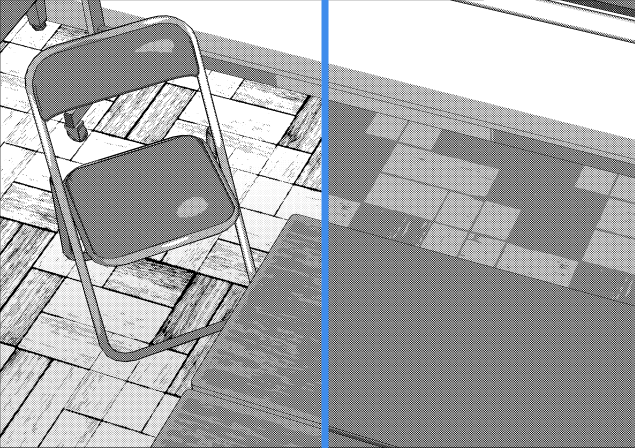Artistic Filter with 3D and Photos
Introduction and Workspace
Hello everyone, welcome to this tutorial, my name is Ed and I am going to show you how I did the windmill next to the river using the new Artistic filter with 3D material and photos to create a painterly effect.
NOTE: This tutorial was originally written in English for the version 1.9.4 of Clip Studio Paint.
▼ You can download the Workspace I am going to use in this tutorial from the links below.
Let's get started!
1. Selecting your material
If you want to combine 3D with photos make sure that you can match the perspective and light between them first. When you use 3D material in Clip Studio Paint you can adjust the direction of the light and that can be very useful when combining different elements.
You can found a variety of 3D materials in Clip Studio Assets. You can buy them with (virtual) gold but you can also download many of them for free. Make sure to include the tag “3D” in your search along with the name of what you are looking for in Clip Studio Assets.
▼ Here is the material I am going to use:
NOTE: If you know how to create your own 3D models you can export them from [File > Import > 3D Data].
■ Now for the photo you can explore images from your travels or browser different stock photos. Consider the lighting and ambient (also colors and texture) when selecting the photo and think in how you could combine it with the 3D material.
I recommend you to use images with one main light where you can easily identify the direction of the light and the shadows.
▼ I am going to use a photo that I took from a creek where I can easily identify the direction of the light from the left and the projection of the shadows.
2. Extract lines and shades/values from 3D material
Create a new document. Select Illustration [Canvas] -width 1920px × 1080 height px- [resolution] 72 with a white paper. Then you can drag the material from the [Material] palette to the canvas. ▼
▲ NOTE: You can change the building/structure from the [Select layout preset] icon (from the bar of the 3D material).
▼ If you want to learn more about how to place the 3D material you can check:
Based on the selected photo I am going to place the 3D windmill with the [Object] tool (shortcut O) to match the perspective from a high position (similar to a bird eye view).
▲ Once you have place the 3D object/material you can edit the light source of the Object from the [Tool Property] palette. Click and move the cursor over the sphere to change the direction of the light to get the shadows that you want or need.
NOTE: Before continuing with the tutorial I recommend you to make a backup of the 3D layer in case you want to edit the light or something else later. You can duplicate the layer and hide it or you can save it in another Clip Studio file. ▼
■ Now after setting the lighting you can duplicate the 3D layer and from [Layer > Rasterize] convert two layers to raster layers before using the artistic filter.
(a) Extract lines from 3D material
Select one of the rasterized layers and hide the others. You can hold ALT+click over the eye icon in the [Layer] palette to visualize just one layer and repeat ALT+click over the eye to show the layers again.
Now from [Filter > Effect >Artistic...] choose [Line only]. You can edit the sliders and numbers to get different results. I think the default values gives you a reasonable result so I try not to move the numbers too much. I only move [Line thickness] and [Line simplicity] when is needed. But in case you want to extract hard edges you can use a low number for [Line anti-aliasing]. And if you increase the numbers of [Line density] and [Line opacity] you will get darker lines.
▼ Here are the numbers I am using for the windmill.
(b) Extract shades/values from 3D material
Select the second of the rasterized layers and make sure the [Color Expression] is set to [Gray] in the [Layer Property] palette. Then from [Filter > Effect >Artistic...] select [Color only] and choose a number between 2 to 6 [Numbers of colors]. The result may vary depending of the material but usually 2 gives you a high contrast and from 3 to 6 gives you more values in between.
▼ Here you can see a high contrast with just 2 colors.
▼ And here are the numbers I am using to extract the shades/values from the windmill.
(c) Combine layers
▲ Using the extracted lines as guides you can add flat colors in new layers. You can paint the windmill, the roof, the windows and so on. You can also use the 3D perspective ruler to help you if necessary.
▲ Now you can use Blending modes to combine the shades/values with the flat colors. I am going to use [Overlay] for the Shades/values layer and place the flat colors below.
▲ Then you can add shadows in a new layer below. You can place the photo below with low opacity to see the projection of the shadows. You can also use the perspective rulers to paint the shadows easily. I am using the [Airbrush] tool in a layer with [Blending Mode] in Multiply and 90% opacity.
▼ If you want to learn how to paint using the rulers you can check:
3. Add painterly effect with photos
Now select the layer with the photo you are going to use to add a painterly effect to it. Remember that it is better if the light and perspective match with the 3D material.
From [Filter > Effect >Artistic...] select [Color only] and choose a high number between 40 to 60 [Numbers of colors] and the result will be similar to a painting. You can also adjust [Color blending] and [Color blur] values to get different results. For example if you want to get sharp edges you should try low numbers around 8 to 16. And if you want blurry and soft edges you should try numbers around 64 to 100.
▲ Here are the numbers I have choose. I am using these numbers to get a soft painterly effect from the photo. After added the effect you can change the layer opacity to combine it with your 3D material.
Finishing touches
Finally, after combine your 3D material with the photo background you can use blur effects from [Filter > Blur] to soft the edges of the extracted lines. I think you have more control adding blur after extracting the lines rather that using the Line anti-aliasing from the Artistic filter.
■ You can also add patterns, textures, correction layers and color map gradients to the artwork.
▼ You can learn more about how to add texture in the link below.
▼ Here is a close up before using blur and adding texture.
▼ And here after adding texture, correction layers and so on.
▼ This is the full frame of the final artwork.
Thanks for following this tutorial! I hope you have found some useful tips here. Please feel free to share your thoughts in the comment section below and don't forget to enjoy creating.
























Comment